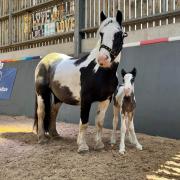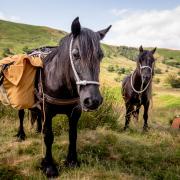Horse racing greats like Desert Orchard as well as many also-rans head for a farm in rural Lancashire when their days on the track are done. Paul Mackenzie reports

Little can compare with the excitement and thrill of a day at the races – the clatter of hooves, the roar of the crowd and the buzz of collecting your winnings. But the noise and exhilaration of the racecourse seem a million miles away from a former dairy farm outside Lancaster.

Many of the 5,000 horses who leave racing and training every year go on to other equestrian disciplines, but for some the future is less certain. For more than 20 years the Thoroughbred Rehabilitation Centre has been offering these horses a home and a suitable environment in which to spend their retirement.
The TRC was founded in 1991 by Carrie Humble MBE and was originally based on a five acre site at Birkrigg Park Arabian Stud, near Kendal. But increasing demand meant she needed to find more space and the centre has moved twice since then – to former livery stables at Nateby near Preston with 60 acres of land and an outdoor manege and to its present base on the 200 acre Whinney Hill Farm at Halton.
They now provide a home for about 25 horses at any time with roughly half coming from post-racing homes where the horse had been bought direct from the trainer, from bloodstock sales or from dealers.
Once they arrive at the centre, new horses go through a thorough health check and a period of assessment before they are put on a programme of training where they will make the transition from a racehorse to a riding horse.
Former teacher Nicky McDonald has been associated with the centre since it began and now, as operations director, runs the centre with the yard manager and the fundraiser. She said: ‘When a horse leaves racing or training it is used to be ridden in a very specific way. It is a highly trained athlete and needs to re-trained to be ridden in a more conventional way.
‘To look after an ex-racehorse you generally need to be very experienced and confident with horses as they can require extra levels of care. They are more complex to look after than a bog-standard pony in a field.
‘A lot of the horses coming to us have been sold to novice owners and not re-trained. These horses in the wrong hands very quickly become unwanted and vulnerable and the consequences for the new owner and the horse can be grim.
‘Thoroughbreds are versatile, intelligent creatures and take to the retraining well but the process has to be handled by professionals who understand the quirks of the thoroughbred and of course the nature of race riding and training
‘We carefully unravel the complexities of the ‘racing’ mind and slowly build a new mind set and retrain to the ‘riding’ horse. Like people, all our horses learn at a different pace – for some the transformation is relatively quick and straight forward for others the process can take longer. Time is never an issue – it takes as long as it takes, but the final product must be a safe, contented horse that is capable of going on to do a job, whether it be hacking or competing.’
Initially, the centre was run by Carrie and two part-time staff caring for just eight horses at a time but there are now 13 people working there. Carrie retired four years ago, having created a centre which is regarded as the role model of racehorse rehabilitation and retraining. It now has an indoor school, stables, a dedicated vet treatment facility, an outdoor school and an oval horsewalker.
Once a horse has been re-trained it is re-homed as part of a loan scheme which carefully matches horses with rigorously-checked loaners all over the UK. ‘We carry out very careful assessments of potential loaners and their property to ensure they are a good match for the horse,’ Nicky added. ‘We don’t want the horse coming back to us – they need that stability.
‘The beauty of our loan scheme is that we are able to monitor the horse for its lifetime and if the loan home does not work out the horse can return to the centre.
‘The loaner gets the full history of the horse and we have a support network with national field officers and loaners can contact staff at the centre to help with problems if they arise.’
In recent years there has been a surge in the popularity of ex-racehorses and an increase in the number of opportunities for them to compete in equestrian disciplines when their racing careers are over. This has lead to more demand for the services offered by the TRC and the handful of similar centres around the country which have followed in the Halton-based centre’s hoofprints.
‘The demand for our work has never been so high,’ Nicky said. ‘We have a massive waiting list of horses requiring a place at the centre and during the winter months the wait can be several months.’
From Humble beginnings
Carrie Humble created the Thoroughbred Rehabilitation Centre because she was concerned about the lack of a formal system for monitoring the welfare of ex-racehorses in the UK.
The centre has been home to some of the biggest names in racing but most of the horses who pass through the yard have not spent much time in the winners’ enclosure.
Desert Orchid, who dominated steeplechase racing in late 1980s, and Earth Summit, the only horse to have won the Grand National and the Welsh and Scottish Nationals, both spent holidays at the centre. And Hallo Dandy, the winner of the 1984 Grand National spent time at the TRC and is buried there.
But Nicky said: ‘The best horses tend to have successful post-racing careers. We tend to deal with the also-rans, the huge pool of ex-racehorses who don’t make it to the very top, they’re the ones that need the help when their careers are over.’
It costs about £1,500 a day to run the Thoroughbred Rehabilitation Centre and although some funding comes from the charitable trust set up by TRC patron Sir Peter O’Sullevan and from racing charity Retraining of Racehorses, the majority is from public donations. To find out more or to make a donation, go to thoroughbredrehabilitationcentre.co.uk



























